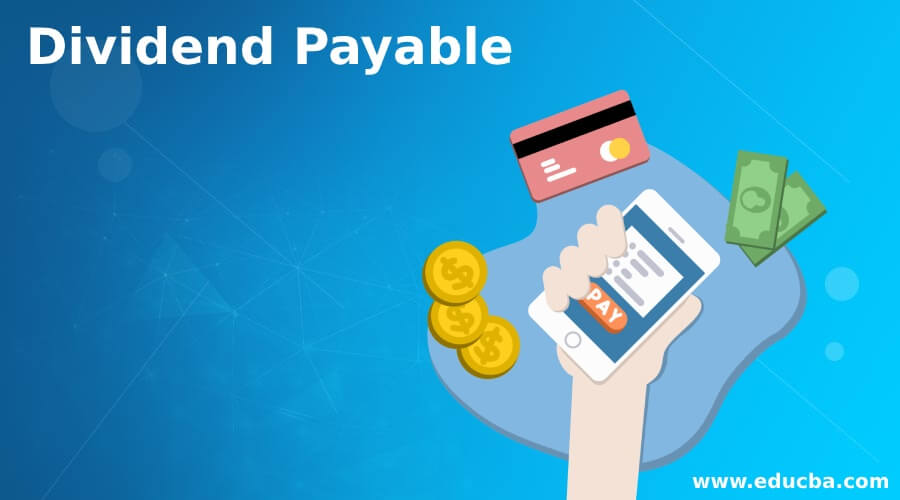Updated October 3, 2023

Definition of Dividend Payable
Dividend payable is a part of accumulated profits authorized by the board of directors to be paid to the company’s shareholders as a return on their investment in the company’s shares. Once the dividend is approved by the company’s directors in their annual general meeting, it becomes payable to the shareholders.Dividend payable is a liability for the company till the time it is paid.
Explanation
Dividend is paid by the company from its after tax profits. After tax profits are the profits calculated by deducting all the expenses and taxes from the revenue. It is also called as retained Earnings. Dividend payable becomes payable only when the board of directors declares and approves it in the annual general meeting. It is a liability of the company and has to be paid within the time frame decided. When the board announces the dividend, an account called ‘Dividend Payable A/c’ is credited with the amount of dividend to be paid, and Retained Earnings A/c is debited with the same amount.
Recording and Example of Dividend Payable
Dividend payable is a short term liability of the company (Short term liabilities are those liabilities which have to be paid within one year). It is shown under the head ‘Current Liabilities’ in the Balance sheet of a company.
There are basically two Journal entries done for recording dividend payable in the books of accounts. The first entry is done at the time of creating liability and another while paying off that liability.
Journal Entry for Recording Dividend Payable
The dividend is paid from the retained earnings of the company, when a dividend is declared by the board, the retained earnings account is debited and the dividend payable account is credited with the amount of dividend to be paid.
Retained Earnings A/c – Debited
Dividend Payable A/c – Credited
The above entry reduces the retained earnings balance and creates a dividend liability for the company.
Journal Entry for Payment of Dividend
When a dividend is paid by the company, the dividend payable account is debited and the cash account is credited with the amount of dividend paid.
Dividend Payable A/c – Debited
Cash A/c – Credited
The above entry eliminates the dividend payable liability and reduces the cash balance with the same amount.
Example
On 15th March 2019, Paul Ltd declares a dividend of $15 per share on its 200,000 outstanding equity shares. The dividend has to be paid on 31st July 2019.
Here, while finalizing its books of accounts for 2019, Paul Ltd will create a short term liability for the dividend payable and reduce the retained earnings with the same amount.
So, Journal Entries are done as follows:
Retained Earnings A/c – Debit ($15 * 200,000)
Dividend Payable A/c – Credit ($15 * 200,000)
(To record dividend payable)
Entry on 31st July 2019
Dividend Payable A/c – Debit ($15 * 200,000)
Cash A/c – Credit ($15 * 200,000)
(To record dividend payment)
Effects of Dividend Payable
There are three accounts affected while journalizing dividend payable in the books of accounts. These are dividends payable, retained earnings, and cash accounts.
- Dividend Payable: Dividend payable is a short-term liability for the company. It is shown under the head current liabilities in the Balance sheet. So, it increases the short-term liabilities of the company.
- Retained Earnings: Dividend is paid from the retained profits of the business. So, distributing dividends reduces the retained profits of the company.
- Cash: Dividend is paid in form of cash or bank transfer, so it affects the cash reserves of the company. It impacts the liquidity of the company. Since the impact is short-term and does not affect the financial stability of the company, it is not much of a concern for the board members.
Dividend Payable vs Dividend Declared
Dividend declared becomes dividend payable once it is approved by the board of directors in the annual general meeting of the company.
Dividend payable is the liability of the company, which arises only when the dividend is declared and authorized by the board.
Advantages
Paying dividend has the following advantages for the company:
- Shareholder Loyalty: Investors are more attracted towards the companies that pay regular dividends to their shareholder.
- Impact on Stock Price: Paying dividend to the shareholders definitely has a positive impact on the company’s stock price.
- Tax Advantages: The dividend income of certain shares attracts lesser/No taxes than other regular income sources.
Disadvantages
Paying dividend has the following disadvantages for the company:
- Impact on Liquidity: Paying dividends has a negative impact on the cash reserves of the company. This cash would otherwise have been utilized for the growth and development of the company.
- Impact on Stock Price: When a company is regularly paying dividend to its shareholders, its stock price remains stable. But once, it fails to pay dividend due to any reason, the investors will start selling their shares which in turn will affect the share price.
Conclusion
Dividend payable is a liability of the company which arises when a dividend is declared by the board of directors. Failure to pay dividend has some serious consequences for the board members and the company. Paying dividends has both advantages and disadvantages for the company.
Recommended Articles
This is a guide to Dividend Payable. Here we also discuss the recording and example of dividend payable along with advantages and disadvantages. You may also have a look at the following articles to learn more –

